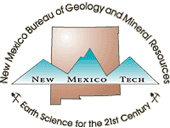revised:
05-Feb-2015
NMBGMR Draft Geologic Data Model - v. 1.0.4
Topology
In the interests of standardization and interoperability, we are migrating our geologic maps into the USGS
NCGMP09 data model. However, our
well data model is still actively being used. Documentation for the NMBGMR geology data model is being provided for users with legacy data in this model. We also hope that it will provoke discussion in the ongoing effort to improve
NCGMP09 and other models.
Overview
Topological rules define the spatial relationships between feature classes
and the constraints within particular feature classes. For instance, geologic
contacts must bound polygons of a particular lithologic unit. Likewise, contacts
cannot have dangles (end in space). These rules are encoded in the geodatabase
and ensure consistency and data integrity.
Cluster Tolerance
Two (or more) points or vertices are considered to be coincident in the geodatabase if the distance between them is less than the cluster tolerance. The cluster tolerance chosen should be dependant on the accuracy of the data. For geologic maps, most data is unlikely to be positioned at an accuracy greater than that of a handheld GPS -- 3 meters at best with WAAS. However, differential GPS positioning can be considerably better. For now a cluster tolerance of 0.01 meters will be used. Points positioned by high-precision GPS should either not participate in the topology (and therefore not be affected by the cluster tolerance) or should have a higher rank in the topology.
Ranks
Each feature class that participates in the topology is relatively ranked based on accuracy. When points or vertices are adjusted because they fall within the cluster tolerance, the point with the lower rank will be moved (1 is the highest rank).
Feature Classes that participate in the topology and their ranks:
- Map_Extent_poly (rank=1) -- the map extent should never be adjusted
- Map_Boundary (rank=2) -- the map boundary should never be adjusted
- Fault_point (rank=3) -- if stations are recorded with GPS they shouldn't be adjusted, if not, they can be snapped to the line during digitizing.
- Fold_point (rank=3) -- as above
- Lith_Contacts (rank=4)
- Fault_line (rank=4)
- Fold_line (rank=4)
- Lith_poly (rank=4)
- Lith_poly_label (rank=4)
Rules (* these rules should be valid before building polygons)
Contacts:
- *Lith_Contacts — no dangles.
- *Lith_Contacts — no intersections.
- *Lith_Contacts cover the boundary of Lith_poly features.
Faults:
- Fault_point is covered by the Fault_line feature class (exceptions allowed
when minor fault data is not on a mapped fault: MappedFeature = FALSE).
- *Fault_line - no intersections.
Folds:
- Fold_point is covered by the Fold_line feature class (exceptions allowed
when minor fold data is not on a mapped fold: MappedFeature = FALSE)
Geologic Units (Lith_poly):
- Lith_poly — no overlap.
- Lith_poly — no gaps.
- Lith_poly covers the Lith_Contacts feature class.
- Lith_poly contains Lith_poly_label feature class.
Map Boundary/Extent:
- Map Boundary polyline is covered by the Lith_poly feature class.
- Map Boundary polyline is covered by the MapExtent polygon feature class.
- MapExtent polygon boundary must be covered by Map Boundary polyline.
